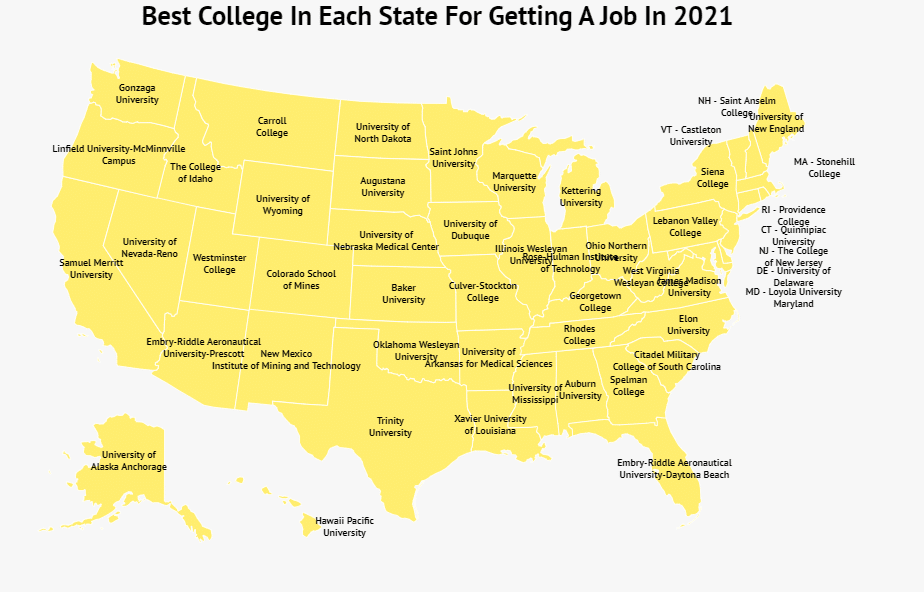- Degree Information
- Certificates And Degrees
- Skills To Learn
Find a Job You Really Want In
- Differences Between Graduate and Undergraduate Programs
- Undergraduate vs. Graduate: Study Length Commitment
- Undergraduate vs. Graduate: Entrance Requirements
- Undergraduate vs. Graduate: Course Content
- Undergraduate vs. Graduate: Class Structure
- Undergraduate vs. Graduate: Tuition
- Undergraduate vs. Graduate: Job Earnings
- Types of Master’s Degrees
- Sign Up For More Advice and Jobs
Higher education is a crucial decision to make, depending on your career path. By pursuing higher education, you can get a foundational knowledge in a particular industry or discipline that will prepare you for your dream career.
Undergraduate or “undergrad” degrees mean you pursue a bachelor’s degree, typically a four-year program at a university or a two-year program at a collect. Graduate students have already obtained a bachelor’s degree and are looking to pursue a master’s or graduate degree. These programs can vary from 2-3 years of commitment, or sometimes longer.
There are differences between graduate and undergraduate programs that are important to understand before making a decision and committing to a certain program.
Key Takeaways:
-
Undergraduate vs. graduate degrees have different entry requirements, tuition costs, and time commitments, but can open up different career opportunities.
-
Compared with undergraduate degrees, graduate degrees tend to have smaller class sizes focusing on more specialized content, and graduate students often have closer mentor relationships with professors.
-
Graduate degrees include Master of Science, Master of Business Administration, Master of Fine Arts, and more.

Differences Between Graduate and Undergraduate Programs
There are significant differences between undergraduate studies and graduate studies regarding the type of degree you’re looking to obtain.
Undergraduate degree programs offer two different degree types:
-
Associate Degree. This degree is the first level of higher education. Typically, associate degrees are offered at community colleges or technical schools.
This type of program allows students to study a general curriculum with specific courses in certain disciplines related to their career aspirations. Associate degrees are optimal if you can’t commit to a four-year program, as they allow you to enter the workforce in various fields.
-
Bachelor’s Degree. This type of degree is the most common. It’s offered by four-year colleges and universities and allows students to focus their education on a specific major, with a minor if they so choose.
A bachelor’s degree will help individuals enter the workforce at an entry-level position or may be required if the individual is looking to pursue a higher level of education.
Graduate degree programs offer a broader variety of degree types:
-
Master’s Degree. A master’s degree can come in all shapes and sizes but is typically focused on a particular research area. Master’s degrees are usually career-specific or can be required to enter a certain field of your choice.
By pursuing a master’s degree, you can enter the workforce at an advanced level or, if you’re already in the workforce, allows you the leverage to push for a promotion or pay raise.
-
Doctoral Degree. A doctoral degree is the most advanced study program and degree you can earn. If you obtain a doctoral degree, you are a certified expert in the field of your choosing. An academic doctoral degree is called a Doctor of Philosophy, most commonly known as Ph D. Individuals who earn these degrees will usually either end up as professor or researcher in their field of study.
-
Professional Degree. A professional degree is still a doctoral degree but is required for certain careers such as law or medicine. Other career areas include Doctor of Education required for educational leadership roles and a Doctor of Pharmacy, which allows individuals to work in certain roles in the pharmaceutical industry.
Undergraduate vs. Graduate: Study Length Commitment
There are varying discrepancies across the programs you might choose. Earning a diploma as an undergrad can vary based on several different things, such as if the individual can attend school full-time or part-time, any transfers, or major changes. Typically these programs are more flexible than graduate programs, where it is more challenging to switch your areas of study or transfer to another school.
Undergraduate Degree Programs
-
Associate degree. This degree typically takes about two years to complete, depending on how many classes you are available to take. There are normally options to take classes back to back or even in the winter and summer semesters to finish your degree quickly.
-
Bachelor’s degree. This type of degree often takes four years to finish, or an additional two years if you have already pursued an associate’s degree. Again, the time this takes to finish will depend on the individual’s ability to take a full course load or not.
Graduate Degree Programs
-
Master’s degree. A master’s degree might take two years to complete, but you can be in for a one- to three-year commitment depending on the program.
-
Academic doctoral degree. An academic doctoral degree can take four to six years or more, depending on the program. Some programs may require learning foreign languages, extensive research, teaching, or publishing work regularly.
-
Professional degree. A professional degree typically takes between three and four years to complete. Medical fields might require individuals to complete additional residencies or internships to finish their degrees.
Undergraduate vs. Graduate: Entrance Requirements
Requirements to get into graduate schools are significantly different than undergraduate programs. While undergraduate programs require high school diplomas, GEDs, or other equivalents to secondary education, graduate programs require completion of an undergraduate program.
For undergraduate programs, they may request things such as
-
SAT or ACT scores
-
Personal essays
-
High-school transcripts
Graduate programs are, of course, much more difficult to access. Beyond your bachelor’s degree, graduate programs often want to see:
-
GRE standardized test scores
-
Writing samples
-
Statements of philosophy
-
Research proposals
-
Letters of recommendation
-
Undergraduate transcripts
If you don’t meet their standards on the submitted application requirements, you may not be eligible for the program.
Undergraduate vs. Graduate: Course Content
Course content and course structure are different between undergraduate and graduate programs. Because of the advanced studies, the coursework will be more targeted and challenging in graduate programs.
In undergraduate programs, course load will vary by school and major type, but it’s typically around 15 credits per semester split between four and six classes. Students in undergraduate programs will be required to take general education subjects and complete courses in English, history, science, and math.
They’re also required to choose a major which allows them to craft a path towards a specific major that will translate to their career path of choice. Students may also choose a minor which will further tailor their studies path to optimize their education for the career or specific job they’re looking to pursue.
In graduate programs, coursework is more specialized and advanced and follows a track of classes or subjects outlined by the specific program. Compared to undergraduate programs, students will usually take nine credits split between three or four courses per semester.
Depending on where students are in their journey, they may need to take exams for the degree, complete large projects, dissertations, portfolios, internships, or other qualifying assignments to obtain their degree.
Undergraduate vs. Graduate: Class Structure
The classroom environments in undergraduate and graduate programs can vary widely. Know what to expect before you commit to any specific program. This will, of course, vary by school and class size, but commonly, undergraduate students can expect the following:
-
Large classes. Undergraduate programs can offer more intimate classes, but for the most part, you should anticipate larger class sizes, especially for general education classes that may be required.
-
Lectures. Lecture classes are a format where the professor teaches the class and students work on their assignments independently. The class structure in a lecture may vary, with professors encouraging questions and discussions, but some may be straightforward teaching without much participation from students.
-
Class discussions. Undergraduate classes can also expect courses centered around discussions, either in a larger format or small, intimate format. This will depend on your area of study, but you can expect this later on in your program when class sizes typically get a little smaller.
Graduate degrees are harder to obtain and less common for individuals to pursue. This means that students in these types of programs can expect the following:
-
Small class sizes. Due to the smaller number of students in any given graduate program, the class sizes are bound to be significantly smaller than undergraduate programs.
-
Elevated discussions. Courses in graduate programs are more intense and focused, often more challenging, and because of this, they tend to be more interactive. Professors may expect students to be overly prepared and actively contribute to discussions in an educated manner.
-
Professor mentoring. Students in graduate programs will work more closely with their professors and normally develop closer relationships with their teachers in this setting. Students can even maintain a close relationship with their professors after graduation and use them as references later in their career journey.
Undergraduate vs. Graduate: Tuition
Depending on the type of college you’re looking at, tuition costs will vary heavily. This will also depend on any scholarships you may have obtained, grants, and whether you attend an in-state school or an out-of-state school. Schools also vary if they are private or public schools.
It’s essential to understand how you’ll pay for tuition and be realistic with what you think you’ll be able to pay back once you graduate.
While by no means a definite figure, you can consult these numbers to get a basic sense of how much each program will cost you:
Undergraduate Prgoram
-
2-year Associate degree: $3,500+/year
-
4-year Assocaite degree: $8,500+/year
-
In-state Bachelor degree: $20,000+/year
-
Out-of-state Bachelor degree: $30,000+/year
Graduate Program
-
Private school: $35,000-$55,000/year
-
Public school: $25,000-$35,000/year
Keep in mind that choosing to attend a graduate program at a school overseas can be a very cost-effective way to pick up a post-graduate degree. You can find graduate programs in Ireland, for instance, for $10,000/year. You’ll just have to go through some paperwork to get a student visa.
Undergraduate vs. Graduate: Job Earnings
Based on your education level, you can gain additional leverage to negotiate pay when you enter the workforce later in your journey. Having a higher education typically correlates to higher potential job earnings.
Earning a certain degree can allow you to work in specific fields that are specialized and will pay more.
Also, some employers may require specific training or education when they’re looking for candidates. If you don’t have the correct education level, you may have a harder time snagging the job.
Types of Master’s Degrees
In the U.S., the most commonly recognized master’s degrees are Master of Arts (MA) and Master of Science (MS or MSc). Another way to break up the types of master’s degrees is to differentiate between course-based and research-based programs.
Course-based programs focus on lectures and seminars, with laboratory or fieldwork as the way of applying classroom knowledge. In research-based programs, students conduct their own research or aid a professor in their field of study.
There is no standardized international system of master’s degree classifications, but the list below will give you an idea of some of the most common options available in the Western world:
-
Master of Arts. MAs are awarded to students who complete a program in humanities, arts, or social sciences. Common undergraduate degrees that lead into a Master of Arts include English Literature, History, Communications, Linguistics, Music, and Art, to name a few.
While the sheer variety of MA programs makes it hard to generalize, students typically hand in a dissertation at the end of their program based on independent fieldwork, study, or a project of their own creation. Examinations, term papers, and smaller collaborative projects may also make up part of students’ grades.
-
Master of Science. An MS is given to students who complete a program in a scientific discipline. Common undergraduate degrees for people who pursue a Master of Science include Biology, Physics, Engineering, Chemistry, and Economics.
Having a Master of Science usually has a bigger impact on career earnings than an MA, but that’s mostly due to the economy emphasizing roles in technology and science. As a percentage, each degree has about the same influence on a graduate’s earnings post-graduation.
-
Master of Business Administration. If you hope to go far in the business world, an MBA is a good option. These programs are built to provide students with the skills to thrive in leadership roles. Some programs require professional experience, so they’re more built around applying your real-world knowledge.
At the same time, many students in these programs work full-time, so they have something to apply their new learning to on a daily basis.
-
Master of Social Work. For folks who want to go have their own practice, conduct high-level research, or be involved in changing macro-level policy, an MSW is an essential ingredient. Those dedicated to social work often pursue an MSW while serving their communities, allowing them to grow as they learn new techniques and get to put them into action.
-
Master of Education. If you want to rise in the educational world, either to an administrative position, one in research or in policy development, then pursuing one of several Master of Education degrees is a good call. You’ll learn more about developing curricula, working with special needs students, or working as an administrator.
-
Master of Fine Arts. MFAs are awarded to students who have excellent skills in performing, visual, musical, or studio arts. Assessment is usually done through judging your work throughout semesters, culminating in a major work. MFAs can be in things like filmmaking, acting, graphic design, or set design, to name a few.
There are plenty more types of master’s degrees out there, but the ones listed above are among the most common you’ll run into.
- Degree Information
- Certificates And Degrees
- Skills To Learn





